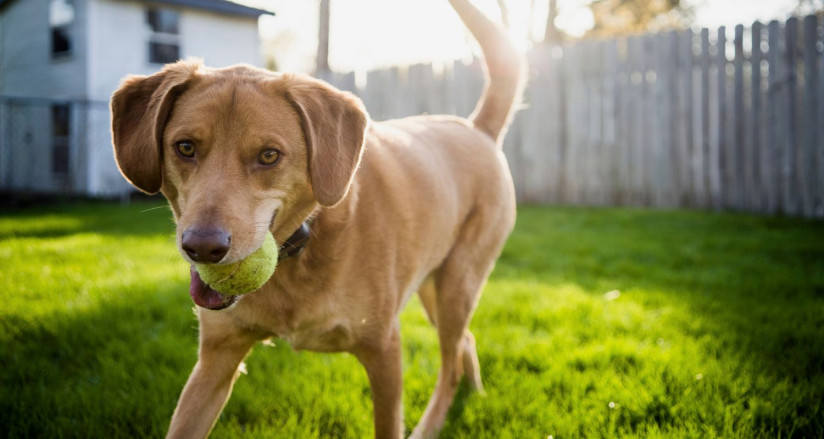Keep Your Dog Safe and Happy in Your Own Backyard
Creating a dog-friendly backyard brings many benefits such as the dog's safety, prevention of boredom and attendant misbehaviors, exercise, and enjoyment of nature.
Dogs kept in a bland backyard all day are far more likely to misbehave with chewing, digging, excessive barking, pacing along the fence, or fence fighting with other dogs. Adapting your yard to make it more comfortable and appealing to your dog will go a long way toward making for a more contented, relaxed canine companion.
Dogs love a good backyard romp - it's the perfect setting to get the exercise and relaxation they need to stay healthy and happy. Before allowing your pup to roam free however, take a took at these tips to avoid destructive or dangerous behaviors and ensure a safe, dog-friendly yard everyone can enjoy.
Create a safe environment
Poisonous Ingestibles
Dogs that are bored, hungry, or both will be tempted to eat poisonous plants, flowers, or mulch (which can be toxic or splinter in their mouths or stomachs). Ask your vet for a list of poisonous plants in your area. Avoid gardening with your dog present – they may conclude that playing with plants and digging are acceptable activities. Be sure to safely store dangerous products like lawn chemicals, fertilizers, weed killers, antifreeze, pesticides, and outdoor grilling supplies like charcoal or lighter fluid.
Fences and Gates
Fences help keep your dog safely on your property and out of harm’s way. If your yard has a traditional chain link or wood fence, be sure all gates latch properly when closed. Fill any holes that may lead to escape with bricks or large stones. Because some homeowners associations do not allow traditional fences, consider creating an outdoor pen for your dog. This will help ensure your pup can safely spend time in your yard.
Lawn Care
Some dogs can be trained to use a specific area of the backyard for toileting. Regardless of where they choose to toilet, be sure to regularly pick up your dog’s waste. You can also water the area of the lawn where your dog urinates after they finish to help minimize damage from the nitrogen in dog urine. Keep your dog (and anyone else!) off the lawn after any treatments with fertilizers, herbicides, or insecticides until the chemicals have completely dried. Also be careful of metal lawn edging, which can seriously cut paws.
Don't forget to cover the essentials
Water
Be sure a large water bowl is readily accessible and always full of fresh water for your dog. If your backyard incorporates a water feature, such as a small pond, be sure it circulates water to help avoid mosquitoes. Still-water ponds need harmful chemical additives to kill the larvae that grows there, which could potentially harm your pup (should they decide to take a drink). If you have a backyard swimming pool, ask us about our pool safety tips.
Shade
Extended time in the blazing sun is just as uncomfortable and dangerous for your dog as it is for humans. Create a cool spot for your pooch in a shady place, where they can relax in comfort – otherwise, your dog may designate their own in a less ideal area of the yard.
Dog Houses
Dogs are more relaxed when they have access to a covered, den-like area. Their doghouse should be raised off the ground to insulate the dog from moisture and chills, large enough for your pup to comfortably turn around, but small enough to retain their body heat.
Place the doghouse next to your family’s house so that your dog feels like it is an extension of the larger den. Provide a blanket or other comfy bedding inside. Choose a house made of a naturally rot resistant material, such as plastic or red cedar, but avoid pressure-treated wood, which can contain arsenic. Use rustproof, galvanized nails and screws. In colder climates, your dog may appreciate a heated doghouse, whether using a doghouse heater or a solar panel.
Avoiding these unwanted backyard behaviors
Chewing
Dogs chew for several reasons, including stress, boredom, teething, or diet deficiency. The easiest way to stop your dog from chewing on things they shouldn’t is to apply a safe, non-toxic doggie repellent. Give your dog an entertaining alternative with a high-quality puzzle toy that offers a treat reward: the GameChanger® and KONG products are great options. Every few days, rotate which toys are available to keep things fresh.
Digging
Dogs dig in search of food, to investigate sounds and smells, to improve their shelter, or to escape. Digging can be triggered by boredom, separation anxiety, chasing rodents or bugs, and nutritional deficiency. A qualified dog behavior therapist, such as a Bark Busters trainer, can determine the reason for your dog’s digging and introduce a training solution.
Scratching at the Back Door
Dogs will scratch and cry at the door because they know all the good, fun stuff is kept inside the house – including you! Ignore this behavior when it occurs, and only let your pup inside when they stop. Correct their behavior from inside the house, rather than going outside to meet them.
Consider giving your dog a chew toy to play with when you put them outside, or scatter food around the yard to appeal to their natural foraging instinct. Bits of safe raw vegetables, dog kibble, or other foods that won’t attract wasps will do the trick. You can even hide a few treats for some extra amusement.
Train your dog and save your yard too
These tips can help create an enjoyable, safe, and dog-friendly backyard, but training may be needed to address the root causes of undesirable behaviors like digging, scratching, and barking.
